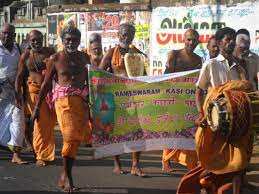Kashi Kavadi : A Significant & Sacred Practice Of Wearing Saffron Robes
Kashi Kavadi : A Cultural practice where a person dressed in saffron robes carries a Kavadi on their shoulder. The Kavadi consists of two baskets or containers covered with a yellow cloth, attached to the Kavadi, and adorned with turmeric, kumkum, and flowers. Inside the Kavadi, idols of Kashi Vishwanath, a revered deity, are placed.
The Kashi Kavadi is not only a physical object but also serves as a visual representation of the journey to Kashi (Varanasi), a holy city in Hinduism. The three-yard picture map attached to the Kavadi horn narrates the pilgrimage of Kashi Vishwanath, including the various places visited during the arduous journey. The story depicts the challenges faced along the way, such as forests, wildlife, rivers, inns, potential thefts, other pilgrimage sites, and the final visit to the Kashi Vishwanath temple.
This storytelling tradition primarily takes place during the daytime and lasts for at least half an hour. The narrator begins by walking around the market, ringing bells, and announcing the Kashi Kavadi. Children are usually the first to gather, followed by elders and women, who sit attentively around the Kavadi. In those times, visiting Kashi was considered a significant undertaking, akin to returning from a foreign country. Through the narrative of the Kashi Kavadi story, listeners would feel as if they had experienced Kashi themselves.
The storytelling session provides a sense of spiritual fulfillment, and listeners would often express their gratitude to the narrator. The figures related to the story are painted in a row on sarees, resembling Bandaru Kalankari dolls/toys, enhancing the visual appeal of the storytelling. The narrators not only share stories about the greatness of Kashi but also incorporate tales of gods from different religious traditions.
Over time, this art form has transitioned, and some narrators have focused more on material gains rather than imparting spiritual and liberation teachings. This shift has led to the perception of the art form being associated with begging, which has diminished its original purpose. However, in its earlier form, Kashi Kavadi was a means of instructing and inspiring the uneducated and served as a medium to transmit stories of devotion, faith, and enlightenment.
Kashi Kavadi & Telugu People
The traditional attire of Telugu people Nanudi says that the traditional attire of Telugu people includes sarees for women, panchakattu for men, and matakattu for villagers. This represents our ancestral culture. In the past, girls would wear gowns and parikini jackets, while young women preferred langavonis. After marriage, women transitioned to wearing sarees. For boys, there were pullovers and knickers, which later evolved into addapancha, panchakattu, and dhotikattu tied with gochi as they grew older. However, with the influence of Western culture, significant changes have occurred in our traditional clothing.
Also Read : Tappeta Gullu : An Important & Significant Traditional Art Form

